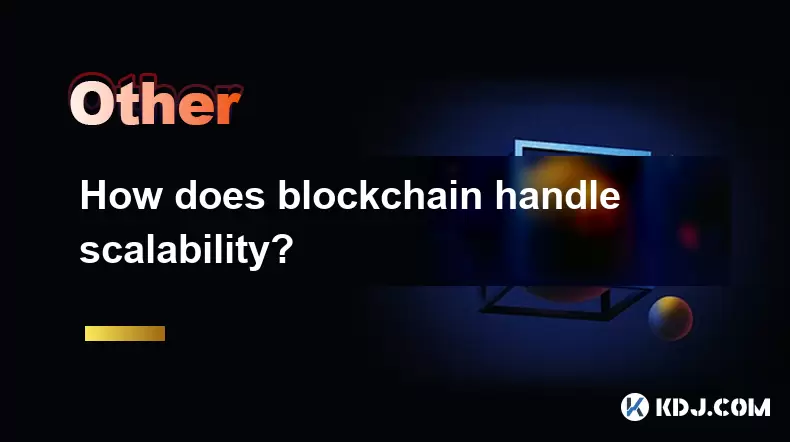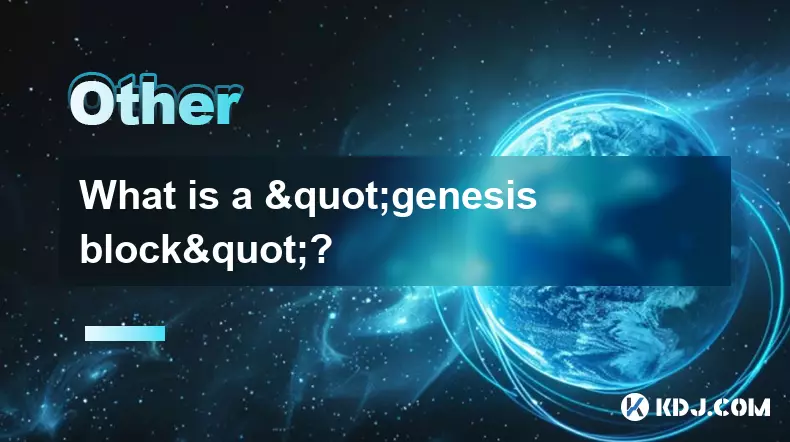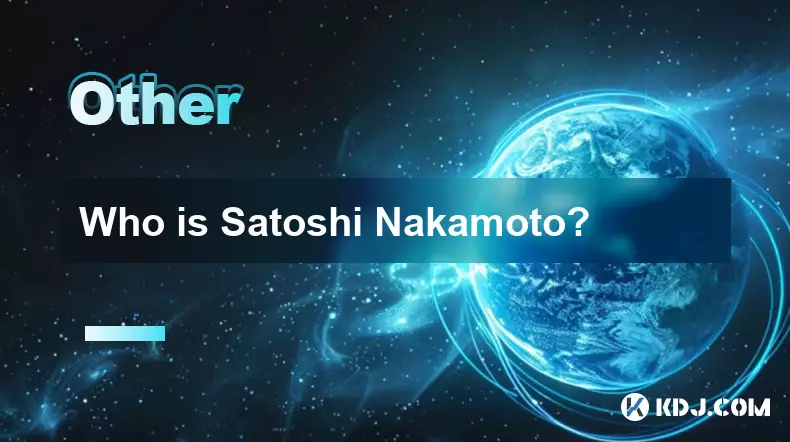-
 bitcoin
bitcoin $100977.009184 USD
-2.05% -
 ethereum
ethereum $3282.009150 USD
-3.23% -
 tether
tether $0.999813 USD
-0.02% -
 xrp
xrp $2.208254 USD
-4.89% -
 bnb
bnb $951.411089 USD
0.55% -
 solana
solana $155.761205 USD
-2.84% -
 usd-coin
usd-coin $1.000217 USD
0.02% -
 tron
tron $0.284475 USD
-1.28% -
 dogecoin
dogecoin $0.162363 USD
-1.53% -
 cardano
cardano $0.533988 USD
-0.47% -
 hyperliquid
hyperliquid $39.174339 USD
-3.22% -
 chainlink
chainlink $14.724828 USD
-1.16% -
 bitcoin-cash
bitcoin-cash $477.297986 USD
-1.28% -
 zcash
zcash $554.227426 USD
17.30% -
 ethena-usde
ethena-usde $0.998995 USD
-0.03%
How does blockchain handle scalability?
Blockchain scalability remains a critical challenge, with Layer 1 and Layer 2 solutions like sharding, rollups, and sidechains offering trade-offs between speed, security, and decentralization.
Aug 02, 2025 at 02:58 pm

Understanding Blockchain Scalability Challenges
Blockchain scalability refers to a network's ability to handle an increasing volume of transactions without compromising speed, cost, or security. As more users join a blockchain network, the number of transactions grows, leading to congestion. This congestion can result in increased transaction fees and longer confirmation times. For example, during periods of high demand, the Bitcoin network has experienced transaction delays of several hours, with fees rising sharply. Similarly, the Ethereum network has faced congestion during popular NFT minting events. The core issue lies in the decentralized nature of blockchains: every node must validate and record every transaction, which inherently limits throughput.
Layer 1 Solutions: Enhancing the Base Protocol
Layer 1 solutions involve modifying the foundational blockchain protocol to improve scalability directly. One prominent method is sharding, which splits the network into smaller partitions called shards. Each shard processes its own transactions and smart contracts, reducing the load on individual nodes. Ethereum’s roadmap includes sharding as a key upgrade, aiming to increase transaction capacity significantly. Another Layer 1 approach is block size increase, used by networks like Bitcoin Cash. By increasing the block size from 1MB to 32MB, more transactions can be included per block. However, larger blocks require more storage and bandwidth, potentially centralizing node operation. Consensus mechanism upgrades also play a role. Ethereum’s transition from Proof of Work (PoW) to Proof of Stake (PoS) reduces energy consumption and allows for faster block finality, indirectly supporting scalability.
Layer 2 Solutions: Building on Top of the Base Chain
Layer 2 solutions operate on top of the existing blockchain to process transactions off-chain, then settle the results back on the main chain. These solutions maintain security while drastically improving throughput. A widely adopted Layer 2 technology is the Lightning Network for Bitcoin. It enables instant, low-cost payments by creating payment channels between users. Transactions within the channel are not broadcast to the main chain until the channel is closed. Ethereum utilizes rollups as a primary Layer 2 strategy. Optimistic Rollups assume transactions are valid by default and only verify them if challenged, while ZK-Rollups use zero-knowledge proofs to validate batches of transactions off-chain before posting them to Ethereum. Both methods reduce on-chain data load, allowing Ethereum to process thousands of transactions per second.
State Channels and Sidechains: Alternative Off-Chain Models
State channels and sidechains offer additional pathways to scalability. State channels allow participants to conduct multiple interactions off-chain, with only the final state recorded on the blockchain. This model is used in projects like Raiden Network for Ethereum. Unlike payment channels, state channels support complex smart contract interactions. Sidechains are independent blockchains that run parallel to the main chain and are connected via a two-way bridge. They use their own consensus mechanisms and can process transactions faster and cheaper. Polygon PoS Chain is a notable example, enabling developers to build scalable dApps while maintaining compatibility with Ethereum. However, sidechains may offer reduced security compared to the main chain, as they rely on their own validator sets.
Data Availability and Compression Techniques
Efficient data handling is crucial for scalability. Data availability ensures that all participants can access transaction data needed to verify the chain. Without it, off-chain solutions could become opaque or vulnerable. Data compression techniques reduce the size of transaction data stored on-chain. For example, EIP-4844 (Proto-Danksharding) introduces blobs—large data containers that hold transaction data off the main execution layer but are still secured by Ethereum’s consensus. This allows rollups to post cheaper data, lowering fees. Sparse Merkle trees and erasure coding are used to verify data integrity without downloading the entire dataset. These innovations enable higher throughput while preserving decentralization and security.
Network-Level Optimizations and Peer-to-Peer Improvements
Beyond protocol and layering strategies, network-level optimizations contribute to scalability. Gossip protocol enhancements improve how nodes propagate transactions and blocks across the network. Faster propagation reduces the chance of forks and increases effective throughput. Compact block relay techniques, such as BIP 152 in Bitcoin, minimize bandwidth usage by sending only transaction identifiers instead of full data, reconstructing missing parts from memory pools. Node pruning allows nodes to discard old transaction data while still validating new blocks, reducing storage requirements and enabling more participants to run full nodes. Additionally, peer selection algorithms prioritize connections with high-bandwidth nodes, improving synchronization speed and network resilience.
Frequently Asked Questions
What is the difference between on-chain and off-chain scaling?On-chain scaling modifies the blockchain’s core protocol—such as increasing block size or implementing sharding—to handle more transactions directly on the main chain. Off-chain scaling, in contrast, moves transaction processing outside the main chain using solutions like state channels, rollups, or sidechains, then settles the final outcome on-chain. Off-chain methods reduce congestion and fees while leveraging the main chain’s security.
How do rollups ensure security while processing transactions off-chain?Rollups maintain security by posting transaction data or proofs to the main chain. Optimistic Rollups use a fraud-proof mechanism: anyone can challenge a transaction within a dispute period, and if fraud is detected, correct state is enforced. ZK-Rollups use cryptographic zero-knowledge proofs that mathematically prove the validity of a batch of transactions before they are accepted. Both rely on the main chain’s consensus for finality and data availability.
Can sharding compromise blockchain security?Sharding can introduce new attack vectors, such as a single shard being targeted by malicious actors if it has fewer validators. To mitigate this, networks use random validator assignment and cross-shard communication protocols. Ethereum plans to implement verifiable random functions (VRF) to randomly assign validators to shards, making it computationally infeasible for attackers to concentrate power in one shard.
Why are sidechains considered less secure than Layer 2 rollups?Sidechains operate with independent consensus mechanisms and validator sets, meaning they do not inherit the main chain’s security. If a sidechain has fewer validators, it becomes more vulnerable to 51% attacks. In contrast, Layer 2 rollups post data or proofs to the main chain, relying on its robust consensus for finality and dispute resolution, thus offering stronger security guarantees.
Disclaimer:info@kdj.com
The information provided is not trading advice. kdj.com does not assume any responsibility for any investments made based on the information provided in this article. Cryptocurrencies are highly volatile and it is highly recommended that you invest with caution after thorough research!
If you believe that the content used on this website infringes your copyright, please contact us immediately (info@kdj.com) and we will delete it promptly.
- BlockDAG, Avalanche, Dogecoin: Crypto's Leading Trio in 2025
- 2025-11-07 22:05:01
- Layer 2 Coins: Will There Be a Potential Explosion by 2026?
- 2025-11-07 16:50:02
- Filecoin, ICP, and the AI Infrastructure Renaissance: Is History Repeating?
- 2025-11-07 16:50:02
- Bitcoin's Wild Ride: Surges, Zeros, and the Search for Stability
- 2025-11-07 17:05:01
- XRP, Bitcoin, and the Rally: What's the Deal, New York?
- 2025-11-07 17:25:01
- Filecoin, DePIN, and a Technical Breakout: What's the Buzz?
- 2025-11-07 17:05:01
Related knowledge

What are the main use cases for blockchain technology beyond cryptocurrency?
Nov 08,2025 at 01:00am
Supply Chain Management1. Blockchain enables transparent tracking of goods from origin to destination, ensuring authenticity and reducing fraud. Each ...

What is a stablecoin and how does it maintain its price stability?
Nov 08,2025 at 12:19am
Understanding Stablecoins in the Cryptocurrency Ecosystem1. A stablecoin is a type of cryptocurrency designed to maintain a consistent value relative ...

What is a block explorer and how do you use it?
Oct 24,2025 at 12:36am
What Is a Block Explorer?1. A block explorer is a web-based tool that allows users to view and analyze data on a blockchain network in real time. It f...

What is the "hash rate" of a blockchain network?
Oct 10,2025 at 03:55pm
Understanding Hash Rate in Blockchain Networks1. The hash rate refers to the total computational power being used to process transactions and mine new...

What is a "genesis block"?
Oct 15,2025 at 07:55pm
Understanding the Genesis Block in CryptocurrencyThe genesis block is the very first block in a blockchain network. It serves as the foundation upon w...

Who is Satoshi Nakamoto?
Oct 15,2025 at 01:01pm
Who is Satoshi Nakamoto?1. Satoshi Nakamoto is the pseudonymous individual or group credited with creating Bitcoin, the first decentralized cryptocurr...

What are the main use cases for blockchain technology beyond cryptocurrency?
Nov 08,2025 at 01:00am
Supply Chain Management1. Blockchain enables transparent tracking of goods from origin to destination, ensuring authenticity and reducing fraud. Each ...

What is a stablecoin and how does it maintain its price stability?
Nov 08,2025 at 12:19am
Understanding Stablecoins in the Cryptocurrency Ecosystem1. A stablecoin is a type of cryptocurrency designed to maintain a consistent value relative ...

What is a block explorer and how do you use it?
Oct 24,2025 at 12:36am
What Is a Block Explorer?1. A block explorer is a web-based tool that allows users to view and analyze data on a blockchain network in real time. It f...

What is the "hash rate" of a blockchain network?
Oct 10,2025 at 03:55pm
Understanding Hash Rate in Blockchain Networks1. The hash rate refers to the total computational power being used to process transactions and mine new...

What is a "genesis block"?
Oct 15,2025 at 07:55pm
Understanding the Genesis Block in CryptocurrencyThe genesis block is the very first block in a blockchain network. It serves as the foundation upon w...

Who is Satoshi Nakamoto?
Oct 15,2025 at 01:01pm
Who is Satoshi Nakamoto?1. Satoshi Nakamoto is the pseudonymous individual or group credited with creating Bitcoin, the first decentralized cryptocurr...
See all articles





















![The Graph Price Prediction [GRT Crypto Price News Today] The Graph Price Prediction [GRT Crypto Price News Today]](/uploads/2025/11/07/cryptocurrencies-news/videos/690d4df44fe69_image_500_375.webp)




















































